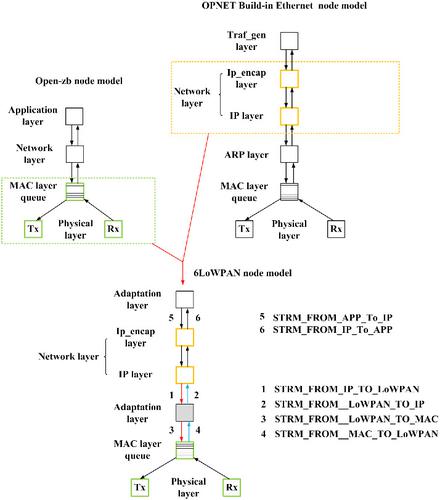当前位置:
X-MOL 学术
›
Trans. Emerg. Telecommun. Technol.
›
论文详情
Our official English website, www.x-mol.net, welcomes your feedback! (Note: you will need to create a separate account there.)
A 6LoWPAN OPNET simulation model for machine‐to‐machine communications
Transactions on Emerging Telecommunications Technologies ( IF 3.6 ) Pub Date : 2020-09-08 , DOI: 10.1002/ett.4120 Dong Chen 1, 2 , Jamil Y. Khan 2 , Jason Brown 3 , Muhammad Awais Javed 4 , Yuan Zhuang 1
Transactions on Emerging Telecommunications Technologies ( IF 3.6 ) Pub Date : 2020-09-08 , DOI: 10.1002/ett.4120 Dong Chen 1, 2 , Jamil Y. Khan 2 , Jason Brown 3 , Muhammad Awais Javed 4 , Yuan Zhuang 1
Affiliation

|
The low‐power short‐range networks have gained prevalence in research fields such as machine‐to‐machine communications and the Internet of things. Given the large number of devices that may exist, the IPv6 over low‐power wireless personal area networks (6LoWPAN) standard is expected to be widely used. Although Contiki, NS‐3, and OMNeT++ have developed the 6LoWPAN model, it is still not available in optimized network engineering tools (OPNET) because it is extremely difficult to interface the built‐in IP module with the customized modules in OPNET. To bridge this gap, we first developed a preliminary 6LoWPAN model and implemented the header compression and header restoration functions to handle the incoming and outgoing packets in OPNET. To further improve the system performance, we also proposed an algorithm that aggregates packets, reduces intranetwork collisions and increases the packet delivery ratio. The model and algorithm in this work are free to download, so researchers from the OPNET community can easily extend this work for their own research in the future.
中文翻译:

用于机器对机器通信的6LoWPAN OPNET仿真模型
低功率短距离网络已在机器对机器通信和物联网等研究领域中普及。考虑到可能存在大量设备,低功耗无线个人局域网(6LoWPAN)标准上的IPv6有望得到广泛使用。尽管Contiki,NS-3和OMNeT ++已经开发了6LoWPAN模型,但是在优化的网络工程工具(OPNET)中仍然无法使用它,因为很难将内置IP模块与OPNET中的自定义模块接口。为了弥合这一差距,我们首先开发了一个初步的6LoWPAN模型,并实现了报头压缩和报头恢复功能来处理OPNET中的传入和传出数据包。为了进一步提高系统性能,我们还提出了一种汇总数据包的算法,减少网络内冲突并提高数据包传递率。这项工作中的模型和算法可免费下载,因此OPNET社区的研究人员可以轻松地将这项工作扩展到自己的研究中。
更新日期:2020-11-05
中文翻译:

用于机器对机器通信的6LoWPAN OPNET仿真模型
低功率短距离网络已在机器对机器通信和物联网等研究领域中普及。考虑到可能存在大量设备,低功耗无线个人局域网(6LoWPAN)标准上的IPv6有望得到广泛使用。尽管Contiki,NS-3和OMNeT ++已经开发了6LoWPAN模型,但是在优化的网络工程工具(OPNET)中仍然无法使用它,因为很难将内置IP模块与OPNET中的自定义模块接口。为了弥合这一差距,我们首先开发了一个初步的6LoWPAN模型,并实现了报头压缩和报头恢复功能来处理OPNET中的传入和传出数据包。为了进一步提高系统性能,我们还提出了一种汇总数据包的算法,减少网络内冲突并提高数据包传递率。这项工作中的模型和算法可免费下载,因此OPNET社区的研究人员可以轻松地将这项工作扩展到自己的研究中。



























 京公网安备 11010802027423号
京公网安备 11010802027423号